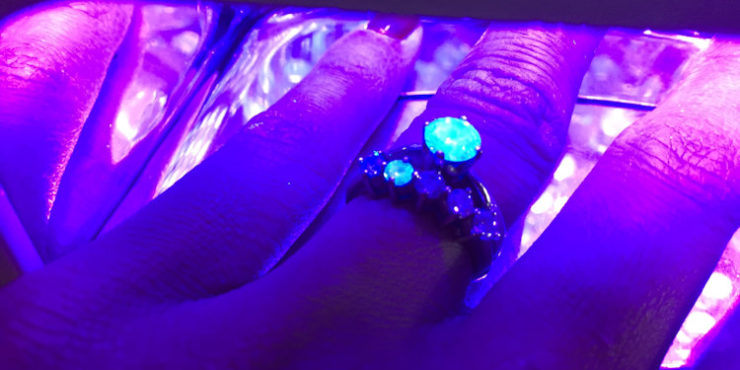Diamonds, precious stones that have been coveted for centuries, offer a palette of colors ranging from utterly colorless to hues that are distinctly yellow or brown. However, a diamond’s beauty extends beyond its apparent color, into a realm illuminated under ultraviolet light — the world of fluorescence.

Fluorescence, which refers to a diamond’s capacity to emit a soft-colored glow when subjected to ultraviolet (UV) light, is a phenomenon that holds a particularly fascinating relationship with the color of diamonds. Even more interestingly, it plays a transformative role in the appearance of lower color grade diamonds, which typically exhibit noticeable color.
The Fundamentals of Diamond Grading
Understanding the relationship between fluorescence and the color of diamonds requires a basic familiarity with diamond grading. The Gemological Institute of America (GIA), a leading authority in gemology, grades diamonds on a color scale that ranges from D (colorless) to Z (noticeable color). Diamonds falling into categories K-Z are considered lower color grade, often displaying a yellowish or brownish tint that can affect their aesthetic appeal and value. It is within these categories that fluorescence can play an intriguing role.
Illuminating the Mysteries of Fluorescence
Before we delve into the effects of fluorescence on lower grade diamonds, it’s important to understand what fluorescence is and how it’s caused. When certain minerals present within a diamond’s structure, like boron and aluminum, are exposed to UV light, they emit visible light, causing the diamond to ‘glow’. This glow is typically blue, though it can occasionally be yellow, white, or another color.
The strength of fluorescence, that is, the intensity of this glow, can vary from ‘none’ to ‘very strong’, and it’s a property that can be observed in around a third of diamonds. While fluorescence is often considered an undesirable trait due to a widely held belief that it can make diamonds look hazy or oily, this is only true for a small percentage of diamonds. Moreover, it can be a ‘hidden gem’ of a trait for lower color grade diamonds, working to their advantage.
The Power of Fluorescence in Color Compensation
The magic of fluorescence in color enhancement lies in color theory. Blue is the complementary color to yellow, meaning when combined, they neutralize each other. This is where blue fluorescence becomes a game changer for lower color grade diamonds that possess a yellowish tinge.
When a diamond with a hint of yellow displays medium to strong blue fluorescence, it has the potential to appear whiter than its color grade would suggest, especially under lighting conditions where UV rays are present, such as sunlight or fluorescent light. This color improvement, or ‘masking effect’, can be quite significant, in some cases making a K grade diamond appear as a H or I grade diamond.
The degree of color enhancement that fluorescence can provide isn’t an exact science and can depend on a variety of factors. These include the diamond’s specific color grade, the strength and color of the fluorescence, and the lighting conditions under which the diamond is viewed.
Fluorescence and Market Perception: A Complex Relationship
Despite its potential benefits for lower color grade diamonds, fluorescence’s impact on a diamond’s market value can be complicated, largely due to prevailing market perceptions. Some people within the diamond trade view fluorescence negatively, seeing it as a defect that can potentially affect a diamond’s clarity and brilliance. This belief, combined with a lack of understanding of fluorescence among consumers, can result in fluorescent diamonds being sold at a discount compared to non-fluorescent diamonds of the same grade.
However, for the discerning buyer who understands the nuances of fluorescence, a lower color grade diamond with medium to strong fluorescence can be an excellent choice. Not only can it offer the visual appeal of a higher color grade diamond, but it can often be purchased at a lower price, representing excellent value for money. This makes lower color grade fluorescent diamonds particularly attractive for budget-conscious buyers or those seeking a unique diamond with a distinctive glow.
The Allure of Lower Grade Diamonds Enhanced by Fluorescence
Fluorescent diamonds, particularly those in the lower color grades that can benefit from a visual color boost, possess a unique allure. The blue glow of a fluorescent diamond, which can be observed under UV light or even in sunlight, adds an extra dimension of beauty and intrigue to the gem. For some, the ethereal blue glow can make a fluorescent diamond more beautiful and desirable than its non-fluorescent counterparts.
A lower color grade diamond with strong blue fluorescence offers a singular aesthetic experience, a combination of subtle color interplay and an intriguing luminescence not found in other gems. Such diamonds challenge the traditional notion that higher color grades are synonymous with superior beauty and desirability. They remind us that each diamond, much like a human fingerprint, carries its unique personality and charm.
In the final analysis, whether fluorescence is considered a beneficial trait or a drawback largely comes down to personal preference. For some buyers, the subtleties of diamond fluorescence and its potential to enhance the color of lower grade diamonds will hold an undeniable allure. For others, the preference may lean